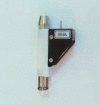Treatment of Chronic Lower Extremity Ulcers with A New Er:Yag Laser Technology
- PMID: 29133969
- PMCID: PMC5675912
- DOI: 10.5978/islsm.17-OR-17
Treatment of Chronic Lower Extremity Ulcers with A New Er:Yag Laser Technology
Abstract
Chronic lower extremity ulcers (CLEUs) have a high prevalence and are difficult to treat due to their various aetiologies. The aim of this study is to evaluate the results achieved in treating CLEUs using an Erbium: YAG (Er:YAG) laser with RecoSMA technology. This laser emits thousands of microbeams of energy causing superficial epidermal ablation and a separation of dermal fibres due to a mechanical-acoustic and resonance effect. The evaluation of the results achieved was carried out by questionnaires completed by 18 patients enrolled in the study. Histological studies and photographs taken before each session (16 sessions in total) were analysed to visually monitor the clinical progress. The analyses were carried out with the help of computer software. The results after 16 treatment sessions showed the complete healing of ulcers or a decrease in their initial area of at least 55% in over 65% of the patients treated. The Student's t-test and Fisher's exact test were used for statistical analysis. The Er:YAG laser and RecoSMA technology ablates few epidermal cell layers, producing a mechanical-acoustic effect with resonance action leading to tissue regeneration mechanisms. This technology offers an effective and safe alternative for treating CLEUs.
Keywords: Chronic lower extremity ulcers; Er:YAG; RecoSMA technology; Ulcers; laser; mechanical-acoustic effect.
Figures






Similar articles
-
Treatment of psoriatic skin lesions with a new Er:Yag laser technology: A case series study.Dermatol Ther. 2020 Mar;33(2):e13264. doi: 10.1111/dth.13264. Epub 2020 Feb 24. Dermatol Ther. 2020. PMID: 32096324
-
Spatially modulated erbium YAG laser as a treatment for diabetic ulcer.J Wound Care. 2023 Oct 1;32(Sup10a):S21-S29. doi: 10.12968/jowc.2023.32.Sup10a.S21. J Wound Care. 2023. PMID: 37830841
-
Facial rejuvenation using Er:YAG laser equipped with a spatially modulated ablation module: A clinical, ultrasound, and histological evaluation.J Cosmet Dermatol. 2019 Oct;18(5):1294-1299. doi: 10.1111/jocd.13083. Epub 2019 Jul 26. J Cosmet Dermatol. 2019. PMID: 31347767
-
Potential applications of Erbium:YAG laser in periodontics.J Periodontal Res. 2004 Aug;39(4):275-85. doi: 10.1111/j.1600-0765.2004.00738.x. J Periodontal Res. 2004. PMID: 15206922 Review.
-
Er:YAG laser treatment of verrucous epidermal nevi.Dermatol Surg. 2004 Mar;30(3):378-81. doi: 10.1111/j.1524-4725.2004.30104.x. Dermatol Surg. 2004. PMID: 15008864 Review.
References
-
- Gloviczki ML, Kalsi H, Gloviczki P, Gibson M, Cha S, Heit JA. Validity of International Classifications of Diseases, Ninth Revision, Clinical Modification codes for estimating the prevalence of venous ulcer. J Vasc Surg Venous Lymphat Disord. 2014; 2(4):362-7. - PubMed
-
- Lal BK. Venous ulcers of the lower extremity: Definition, epidemiology, and economic and social burdens. Semin Vasc Surg. 2015; 28(1):3-5. - PubMed
-
- Alavi A, Sibbald RG, Phillips TJ, et al. What's new: Management of venous leg ulcers: Approach to venous leg ulcers. J Am Acad Dermatol. 2016; 74(4):627-40. - PubMed
-
- Martínez Carpio PA, Trelles MA. El láser y la fotónica en la Cirugía Plástica española e iberoamericana. Antecedentes históricos, aplicaciones actuales y proyectos de desarrollo inmediato. Cir Plást Iberolatinoam. 2010; 36(1):59-78.
-
- Komchenko V. Treatment of Non-healing Wounds with Erbium Lasers. Actual Surgical Questions. The 15th Congress of Surgeons of the Republic of Belarus. Congress Material Extracts, Brest Ed, “Alternative” 2014; 44-5.
LinkOut - more resources
Full Text Sources
Other Literature Sources
